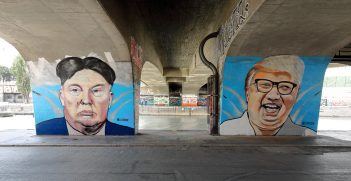The Singapore-Malaysia High Speed Railway: New Challenges in Bilateral Relations

Financial burden sharing, economic competition and further integration will not only make the high speed railway between Kuala Lumpur and Singapore a new form of transportation, but could also present new challenges in bilateral relations.
The plan for the high speed railway connecting these two capitals is driven by two motives: transportation and regional development.
With continuous economic growth, the demand for transportation between the two largest metropolises on the Malay Peninsula is increasing, and there is a gap in the current means of transportation, including rail, super highways and aviation. The conventional railway is slow, due to its detoured lines and narrow gauge, and the super highways are constrained with traffic jams, especially at the two border checkpoints. Aviation is limited by the remote locations of airports and vulnerability to climate conditions. The Malaysian government is looking for major infrastructure projects to bring in regional development, in order to boost its economy. The high speed railway line will be about 340 kilometres long, including two terminals in Kuala Lumpur and Singapore, as well as five transit stations, and is designed to inspire the development of the Southern Corridor in Malaysia and to strengthen bilateral economic ties across the Johor Strait. As a result, both countries would benefit economically, and would have greater influence in the region, and may contribute to continuing the economic lead which has been ahead of other neighbouring states since the 1960s. This high speed railway line could also be part of the Kunming-Singapore railway, placing it within China’s “one-belt one road” strategy.
Two Challenges
Funding and competition are the two major challenges. In conventional wisdom, Singapore and Malaysia would need to be responsible for the construction of the tracks, stations and other facilities in their respective territories, as well as similar expenditure on rolling stock. However, the estimated benefits for Singapore could be out of proportion to the short section of line in its territory, and Kuala Lumpur may request Singapore to shoulder a higher financial burden. It is too early to estimate how much of the costs Singapore will cover, but it’s likely to be larger than the small portion of the line in its territory..
If the high speed railway can carry enough passengers, either shifting from air transport, buses, automobile or as new customers, the investment is likely to be gradually recovered, leading to further profit for both countries. Conversely, according to experience in China, Spain, Italy, South Korea and Taiwan, overestimation of the number of passengers and revenue is likely. As such, the continuous and possible increasing financial costs of construction and operation would affect both countries, and might evolve into bilateral disputes.
As the two end points of the high speed railway line Singapore and Kuala Lumpur may enter serious economic competition. Previous experience of high speed railways in Japan and France shows that they concentrate economic activities in major cities along the line. For example, the Tokaido Shinkansen between Tokyo and Osaka benefits the former more than latter. A similar situation also occurs on the French “Train a Grande Vitesse (TGV)” between Paris and Lyon.
Although the Malaysian government is aiming at regional development along the line in its territory, economic concentration of the benefits in Kuala Lumpur and Singapore may be unavoidable. Unlike London and Paris, connected through the Euro Star high speed train, Singapore and Kuala Lumpur have similar demographies, culture and language, and may see more intense competition than in Europe.
On the one hand, Singapore may be less attractive than Kuala Lumpur due to immigration check points and customs at the border. On the other hand, Singapore, with larger economic scale and better facilities than that of Kuala Lumpur, may form stronger economic integration with the Southern Corridor in Malaysia. During the process of economic interaction and redistribution, both countries may face some economic and social challenges which, potentially, could be blamed on each other.
Bilateral Effects
After the completion of the railway, the tighter economic and other integration across the Johor Strait would be unavoidable, and this trend would affect both countries. Since the independence of 1965, Singapore has worked hard to balance trade and relations in order not to depend too much on any specific country. Despite various efforts to diversify trade and investment, Malaysia has always been the top or second trade partner for Singapore for decades, due to its adjacency and the economic ties established before separation.
There is no doubt that the high speed railway would enhance bilateral trade and investment, but Malaysia’s economic integration with Singapore may not result in more competition, as its has a generally lower ranking than Singapore in the Global Competitiveness Index.
Uncertainty
Although national leaders of both countries expressed their willingness to build the high speed railway in May, a “misquote” from the Malaysian CEO of Land Public Transport Commission about ending the high speed railway in Johor, rather than Singapore, implies uncertainty. Furthermore, funding, the exact locations of lines and other technical details have not yet been announced, so that there is potential for major changes before final settlement. If the railway line is built in the Malaysian territory alone, a heavier financial burden would be imposed on Kuala Lumpur, and Singapore would face some opportunity costs. However, Malaysia, with full responsibility for the project, would enjoy full economic benefits, and Singapore could avoid the risk of investment and save its precious land for other purposes. The rail line without crossing the border could prevent both parties from further disputes. If the high speed railway project will still end in Singapore as planned, it may reshape the bilateral relations between Malaysia and Singapore, and present new challenges for both.
Dr Shang-su Wu is a Research Fellow in the Military Studies Programme of the S. Rajaratnam School of International Studies (RSIS), Nanyang Technological University, Singapore. This article can be republished with attribution under a Creative Commons Licence.





